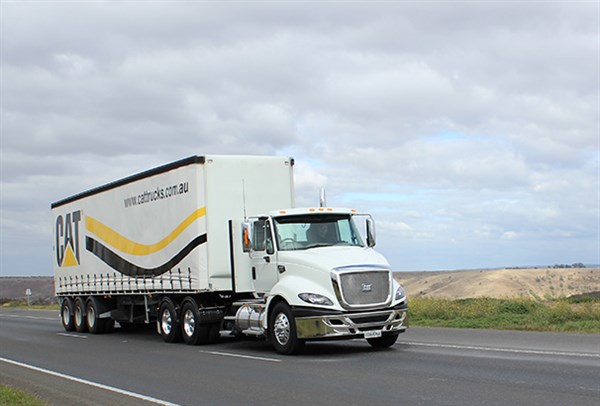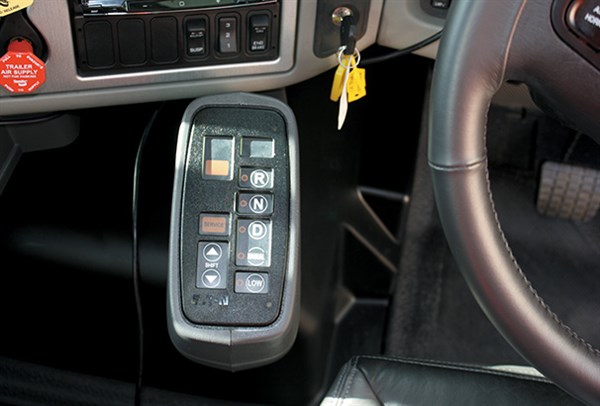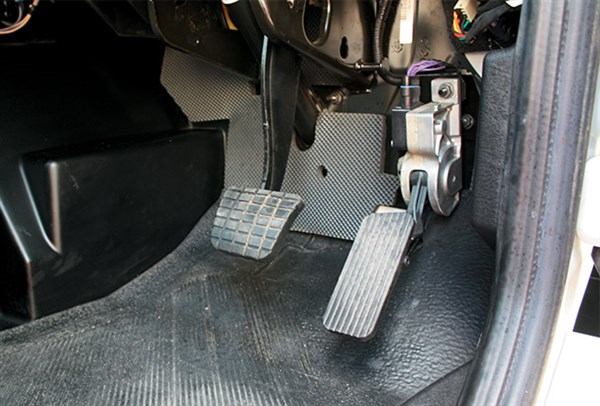After driving the new CAT CT610 from Brisbane to Melbourne, dedicated cog swapper Matt Wood takes the AMT version for a quick spin to see how the Eaton UltraShift Plus behaves behind the new EGR engine
To my mind, an AMT that requires a lot of driver intervention is like a dud TV remote control. If you have to muck around with it constantly, you may as well just have a gear stick.
I’ve already written about the new Cat CT610 and the new CT13 exhaust gas recirculation (EGR) engine. I even drove the manual version from Brisbane to Melbourne.
What I didn’t mention was that I also had a short stint in the Eaton UltraShift equipped model, for about 70km, and I wasn’t overly impressed.
Engine and Transmission
The CT13, a cooled EGR 6-cylinder in-line engine with 475hp (354kW) of power, has a long flat torque curve that gives peak torque from 1,000rpm. It doesn’t need a great deal to get it up and running from a standstill.
The first time I drove the AMT, I found that it shifted too hard, held on to gear changes too long and, as a consequence, was very slow off the line.
It wasn’t until the transmission was in high range that the engine and gearbox seemed to meet up. The 1,700rpm peak horsepower sweet spot of the CT13 meant that once it was moving it was happy and eager, but getting up to speed in city conditions was a dead-set pain.
A change of AMT program and a bit of a tweak saw me catch up with the truck again in Melbourne to have another go. The results were like night and day.
When I’d previously driven the AMT-equipped CT610 the Eaton cog box had a performance program installed in its little computer brain.
This program was the reason that the AMT was thinking that it was pulling three trailers up the side of a cliff, rather than one trailer on a paved road.
The split personality of the CT13 engine means that it’s content to shuffle quietly through the gears in low range, and then wind out a bit more in high range once a bit of road speed has been gained.
In the couple of weeks since I’d first driven the AMT Cat, the transmission software had been changed to a more sedately shifting standard-performance setting.
Performance
As I was already familiar with the truck and engine, there wasn’t a great deal of need to go for a huge drive. Instead, a mosey on down the infernally snarled Western Ring Road, a stroll through Melton, and then a drag up the Pentland Hills on the way to Ballarat and return was the plan.
But, within a couple of minutes of being on the road, I already could tell that the AMT was playing ball as the truck rolled though low range gear changes quickly, quietly and efficiently.
It’s quite common to hear people excuse AMTs that don’t perform by saying: “Well the transmission can’t see the road ahead.”
Of course, with maybe the recent exception of Volvo’s I-See global positioning system (GPS) cruise control, this is true. But I reckon this has become a cop-out rather than an acknowledgement of the limitations of some AMTs.
Through the traffic, the Eaton box didn’t put a foot wrong and happily skip-shifted as we rolled through the outer western suburbs of Melbourne.
Out on the highway the CT610 settled got up to speed and started to eat up some kilometres. The climb up the Pentland Hills at 42,500kg gross was a bit of a test for the baby Cat, but more-so for the transmission.
Left to its own devices, the truck will lug down and climb. But this truck had the standard fitment 3.90:1 final drive, which means that to get the most out of it, you have to drop out of overdrive before the start of a long grade.
Another aspect of the Cat AMT installation that does require some driver intervention is the CT13’s engine braking capabilities.
The ultra-quiet jake brake on the Cat performs admirably on long descents. But with the tall final drive ratio, it isn’t hugely effective for bleeding off speed on the highway.
You really need to drop it down a gear or two manually to get it to hold you back on a long highway grade with peak engine braking at 1,900rpm.
That’s the main point with the CT610 AMT; I’d think that most buyers who would buy an AMT in this kind of truck are going to spend the bulk of their time running around town.
Personally, I think that the AMT model should have a standard diff ratio of 4.10:1 rather than the 3.9:1 it comes out of the box with — the 4.1 ratio is an option.
This would make the most of the CT610’s city-paced performance but also give more effective engine braking when needed, especially for tipper roles.
The highway is a different story and, as with the manual version the CT610, trundled along the open road with ease.
Just like its manual sibling, it needed a pre-emptive down change out of overdrive to get a launch at a climb.
Of course, you may ask, why bother with the Eaton AMT at all? Especially when the Euro manufacturers seem to have the AMT concept all sewn-up, and when it comes to low-speed manourvreing and tasks like hooking up trailers.
The answer to that question is mainly one of cost; the Eaton AMT is still essentially a manual Roadranger with a computer and servo module attached. The basic nuts and bolts of the transmission have been around forever and you’d be hard pressed to find anyone who wouldn’t be able to work on one.
The fact also remains that the Eaton Roadranger would still have to be one of the cheapest heavy vehicle transmissions to rebuild, and parts are plentiful.
Verdict

Most Euro AMTs use an organic clutch plate that provides smooth and seamless hook-up when the clutch is engaged; the organic clutch can slip or partially engage to let a vehicle creep backward into a loading dock.
The Eaton box uses a ceramic clutch plate. The ceramic plate tends to be sturdier and disperses heat quite effectively. Unfortunately, the tradeoff for the heavier duty ceramic clutch plate is its performance at low speed.
The engagement can be clunky and when reversing it can seem to grab as the clutch won’t slip or ride — it’s either engaged or it’s not.
Eaton has chosen durability and ease of service over the low-speed performance offered by the Euros.
And it’s a choice that many customers have been willing to go with.
The UltraShift CT610 is a quiet easy truck to operate. I found the Eaton application in the Cat a nice job, though my preference would be to go with the cobra style T-bar shift rather than the push button style installed in the CT610 I drove. Anyway, I have enough trouble with the buttons on my TV remote at home.
Specifications
Make/Model: CAT CT610
Engine: Cat CT13 cooled EGR 6-cylinder, in-line, dual sequential turbocharged and aftercooled, high pressure common rail fuel injection system
Power: 475hp (354kW)
Torque: 1700lb.ft @1000rpm
Transmission: Eaton Fuller RTLO-18918B 18-speed overdrive OR Eaton Ultra Shift PLUS with HAS
GCM: Up to 58 tonnes





